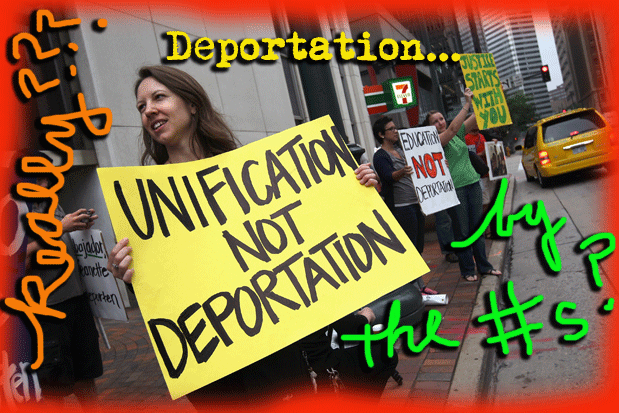DEPORTING GRANDMA
In its desire to look tough on immigration for swing voters, is the Obama administration filling its numbers quotas by deporting legal immigrant grandmas (and others) who broke the law 20 years ago?
by Matthew Fleischer
Late last month, the LA Times’ Brian Bennett reported a fascinating story on a growing trend in U.S. immigration policy. As of May 14, U.S. Immigration and Customs Enforcement (ICE) have boosted the number of agents responsible for deportations by 25 percent in response to “a shortfall in criminal removals for the fiscal year.”
According to a document obtained by Bennett, ICE was boosting its number of “fugitive operation teams” from 104 to 129, with each team responsible for bringing in 50 suspects for month.
Wrote Bennett: “The fugitive teams were instructed for the first time this month to focus chiefly on finding and deporting illegal immigrants convicted of a felony or more than two misdemeanors, multiple immigration violations, or having used fraudulent documents, and not on broader categories of illegal immigrants.”
It’s an election year and deporting illegal immigrants with criminal records, not law abiding undocumented residents seems, like a political win-win for Obama. But here was the surprising twist: according to the Times, the plan explicitly called for the deportation of people who “pose no security risk,”
That line got me curious. Who are these “no risk” people and why are we spending resources to deport them, even as ICE admits they’re harmless? I spoke with Adrian Cid Uribe, a Pasadena-based criminal defense attorney who handles this specific type of immigration case—post-conviction deportation.
Uribe says he’s seeing an increasing number of clients facing deportation over minor criminal convictions from decades ago.
And here’s the kicker: while Bennett’s article refers to “no security risk” people who are illegal immigrants, a great many of Uribe’s clients are permanent legal residents, many of whom have been in the US since childhood. They too have become deportation targets under the Obama plan because they broke the law during their residency in the U.S.
“Most of my clients are older and came to America legally on a work visa or as a political refugee,” he told me. “We’re talking about grandmothers and patriarchs of the family. They’re later in life. They’ve already established themselves–furniture-makers or skilled craftsman. I’m a private attorney. They have to pay me, so these are people of means, homeowners. They’re adults who are grandparents, with American-born spouses. They’re just like anyone else, really, but they have a skeleton in their closet.”
The skeletons are otherwise known as a “crimes of moral turpitude”—a legally fuzzy term that generally refers to drug charges, prostitution or petty theft. Many of Uribe’s clients were busted in the 80’s for a crime that wasn’t (at the time, anyway) deemed significant enough for deportation. In 1996, however, the Illegal Immigration Reform and Immigrant Responsibility Act was signed into law by then-President Clinton, which mandated that legal immigrants who break the law be deported to their country of origin. Yet, even then, none of Uribe’s clients had any trouble getting their Visas renewed.
“Back then no one cared. It wasn’t until 9/11 that this became a big issue.”
Post-conviction deportations ramped up under president Bush—but nothing like the new Obama plan, where non-violent criminal offenders seem now to be explicitly targeted when the numbers are needed, illegal and legal residents, alike.
One of Uribe’s clients was recently pulled over for a minor traffic violation, only to find out he was wanted for deportation by ICE for a two decade-old marijuana offense. Another client is a grandma whose last run-in with the law was a misdemeanor in the early 80’s.
So what exactly is the logic in deporting otherwise law-abiding people who committed non-serious offenses ten, fifteen or twenty years?
“ICE is hampered by sheer numbers,” explains immigration law expert and Bender’s Immigration Bulletin editor Dan Kowalski. “Their target is 400,000. That’s approximately the maximum number of people the system can process in a given year. ICE is taxed with maximizing that capacity. As long as they can make it, they can use their discretion.”
What that basically means is that when immigrants are streaming over the border illegally, ICE’s job becomes much easier. They can simply go after the low-hanging fruit of new immigrants with few familial ties to this country. But since the flow of illegal border crossings has slowed due to the economic downturn, who does ICE go after–especially in an election year, where Latino voters will be crucial in swing-states like New Mexico, Colorado and Florida?
Obama is navigating this political minefield by leaving law-abiding DREAM-Act immigrants alone and focusing exclusively on immigrants with criminal convictions, some undocumented, many not.
“It’s all about discretion,” says Kawalski. “It’s about focusing on criminals vs. non-criminals, like the DREAM act group. Then further sub-dividing the criminal group into the worst of the worst.”
Worst of the worst meaning murderers or repeat gang violence offenders—not elderly homeowners who experimented with weed in the ‘80s and got busted.
Of course, there’s no legal mandate that dictates ICE must deport people at maximum capacity. That quota is politically driven.
“Obama needs the Latino voter,” says Kowalski, “but also the swing voter who wants to know a candidate is tough on immigration. It’s a balancing act to be sure.
“If they’re behind on the numbers, they’ll take grandma.”
Photo by John Moore/Getty

